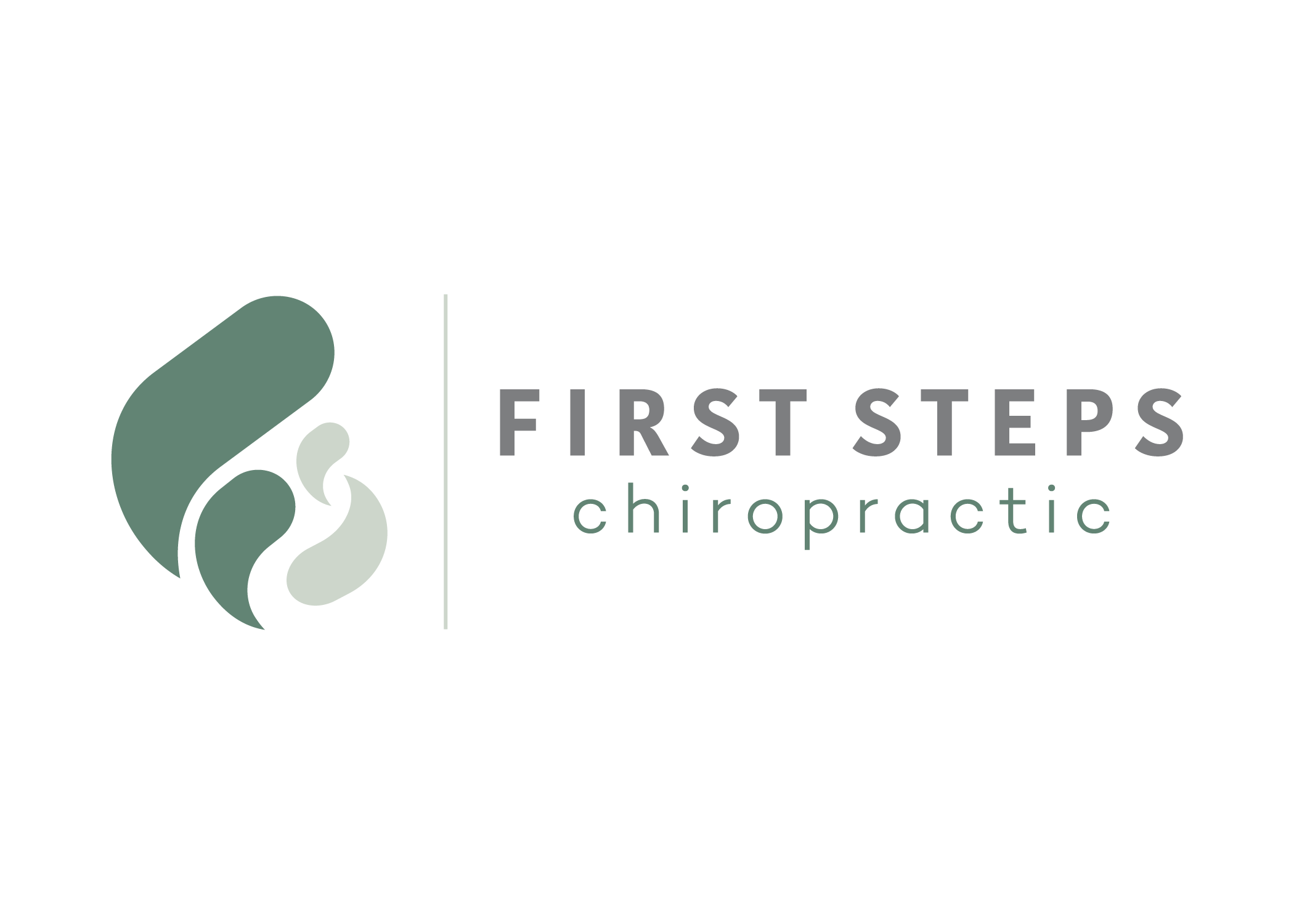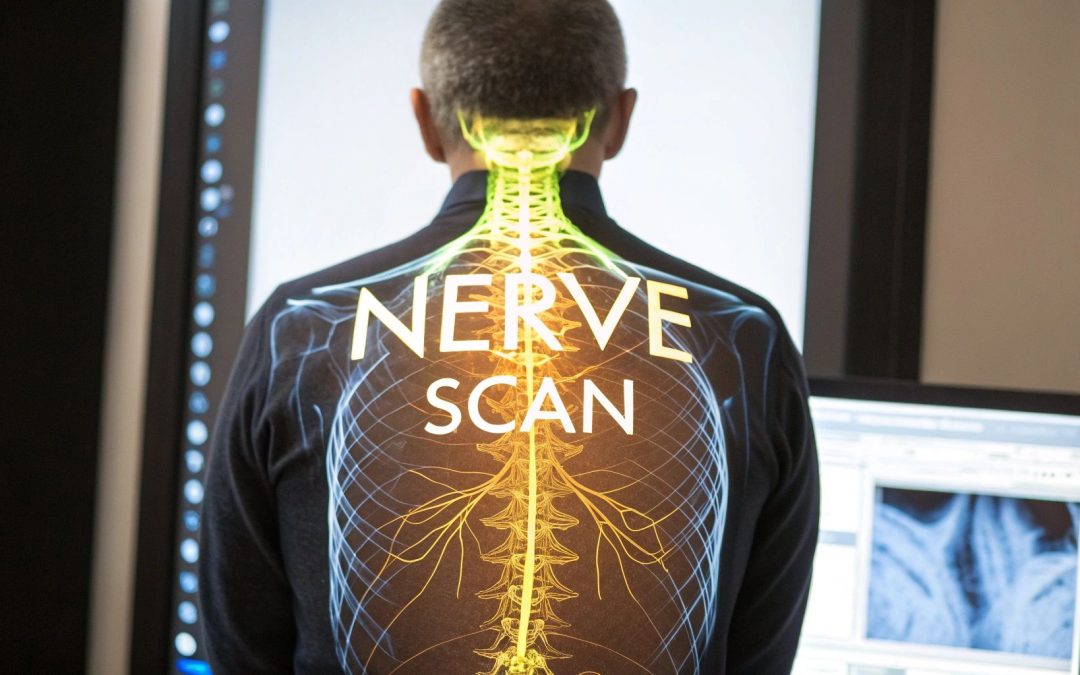Imagine your body's nervous system is like the intricate electrical wiring of a house. A chiropractic nerve scan acts like a master electrician's most advanced diagnostic tool, letting us see exactly where the circuits are overloaded or failing—all without having to tear down any walls.
This technology gives us real, objective data. It moves us past the guesswork and helps us pinpoint the true source of your health challenges.
Demystifying the Chiropractic Nerve Scan
So, what exactly is a chiropractic nerve scan? It’s a completely non-invasive process that uses some pretty amazing technology to measure how well your central nervous system is functioning and how balanced it is.
The goal isn't to diagnose a specific disease. Instead, think of it as a detailed report card on your body's internal communication network. It's perfectly safe, totally painless, and involves zero radiation, which is why it's a great tool for everyone, from pregnant moms to young kids.
At its heart, the scan gives your chiropractor a window into what’s happening beneath the surface. You might be feeling symptoms like pain, fatigue, or anxiety, but the scan shows us the hidden neurological stress patterns that are likely causing those feelings. It helps us answer that all-important question: "Why is my body having such a hard time adapting?"
The Three Core Components of a Chiropractic Nerve Scan
To get a complete picture of your nervous system's health, the process actually involves three different scans. Each one provides a unique and complementary piece of the puzzle, and together, they tell us a comprehensive story.
Here's a breakdown of what each scan does and what it tells us about your health.
| Scan Type | What It Measures | What It Reveals About Your Health |
|---|---|---|
| Thermal Scan (Thermography) | Temperature differences along each side of your spine. | Shows where inflammation and nerve irritation might be interfering with your body's communication system. |
| Surface Electromyography (sEMG) | The amount of electrical activity in the muscles that support your spine. | Detects hidden patterns of muscle tension, weakness, or even exhaustion that point to underlying stress. |
| Heart Rate Variability (HRV) | The variation in time between your heartbeats. | Provides a powerful look into your body’s ability to handle stress, recover, and stay resilient. |
By combining these three scans, we get a multi-faceted view of your neurological function, allowing for a much more precise and personalized approach to your care from day one.
"A nerve scan translates what your body is experiencing into a language we can both understand. It makes the invisible visible, giving us a clear, data-driven starting point for your care."
Putting all this technology together has been a huge leap forward for chiropractic care. Advancements like NeuroTHERMAL scanning, which precisely measures temperature along the spine to find nerve stress, have changed the game. When we combine that with sEMG and Heart Rate Variability (HRV) scans, we shift from subjective feelings to evidence-based care. If you're curious, you can learn more about these top innovations in chiropractic scanning equipment.
This image gives you a great visual of how we take that sensor data, analyze it, and turn it into clear recommendations for your treatment.
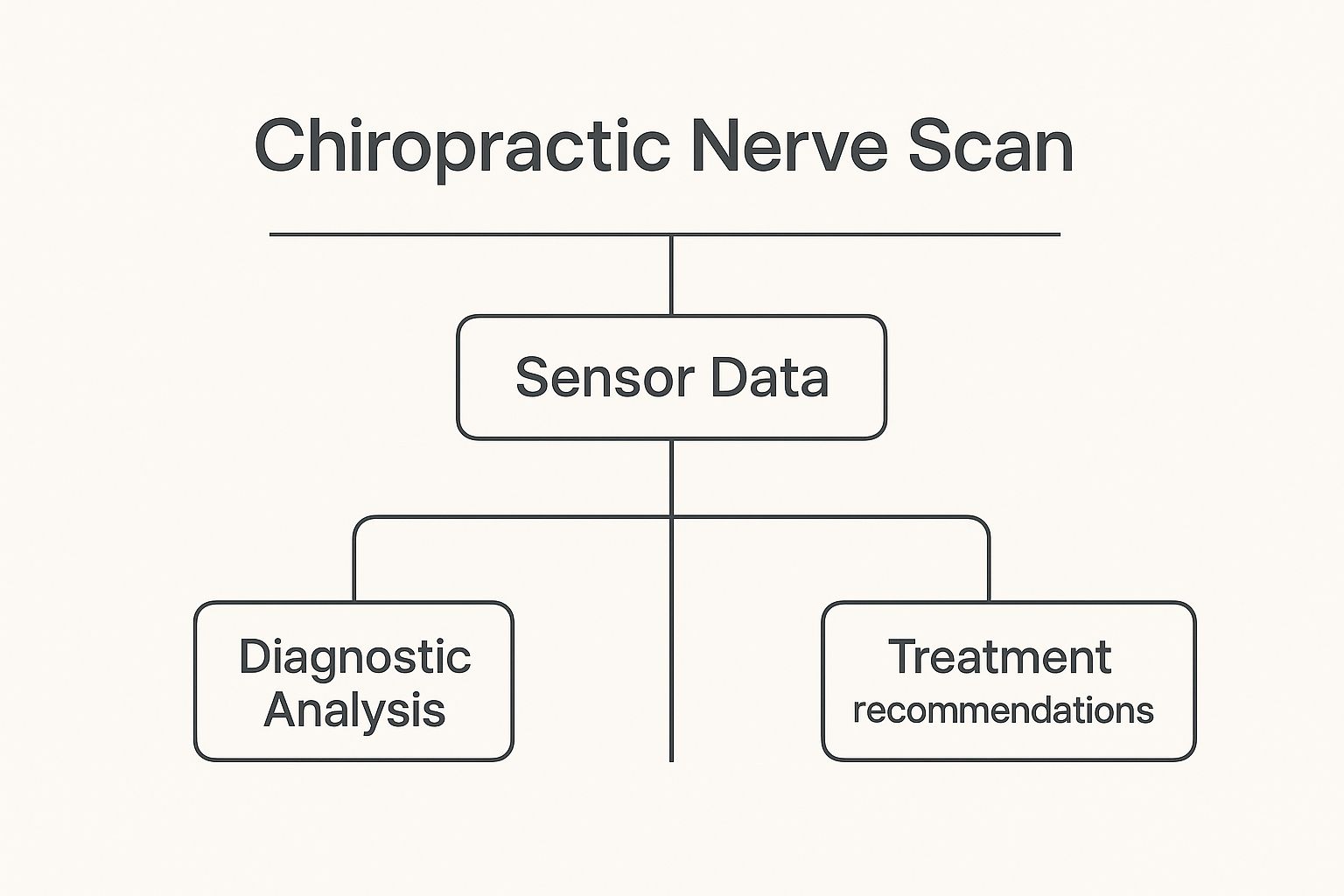
Ultimately, this entire process is about giving you a clear and reassuring answer right from the very beginning of your health journey with us.
How Nerve Scan Technology Reveals Your Health Story
A chiropractic nerve scan does much more than just identify problems—it tells the detailed story of how your body is actually handling the stresses of daily life. It takes the subtle, invisible signals firing through your nervous system and translates them into a clear, visual report we can both understand.
Let’s look under the hood at the three key technologies that work together to create this complete picture of your health.
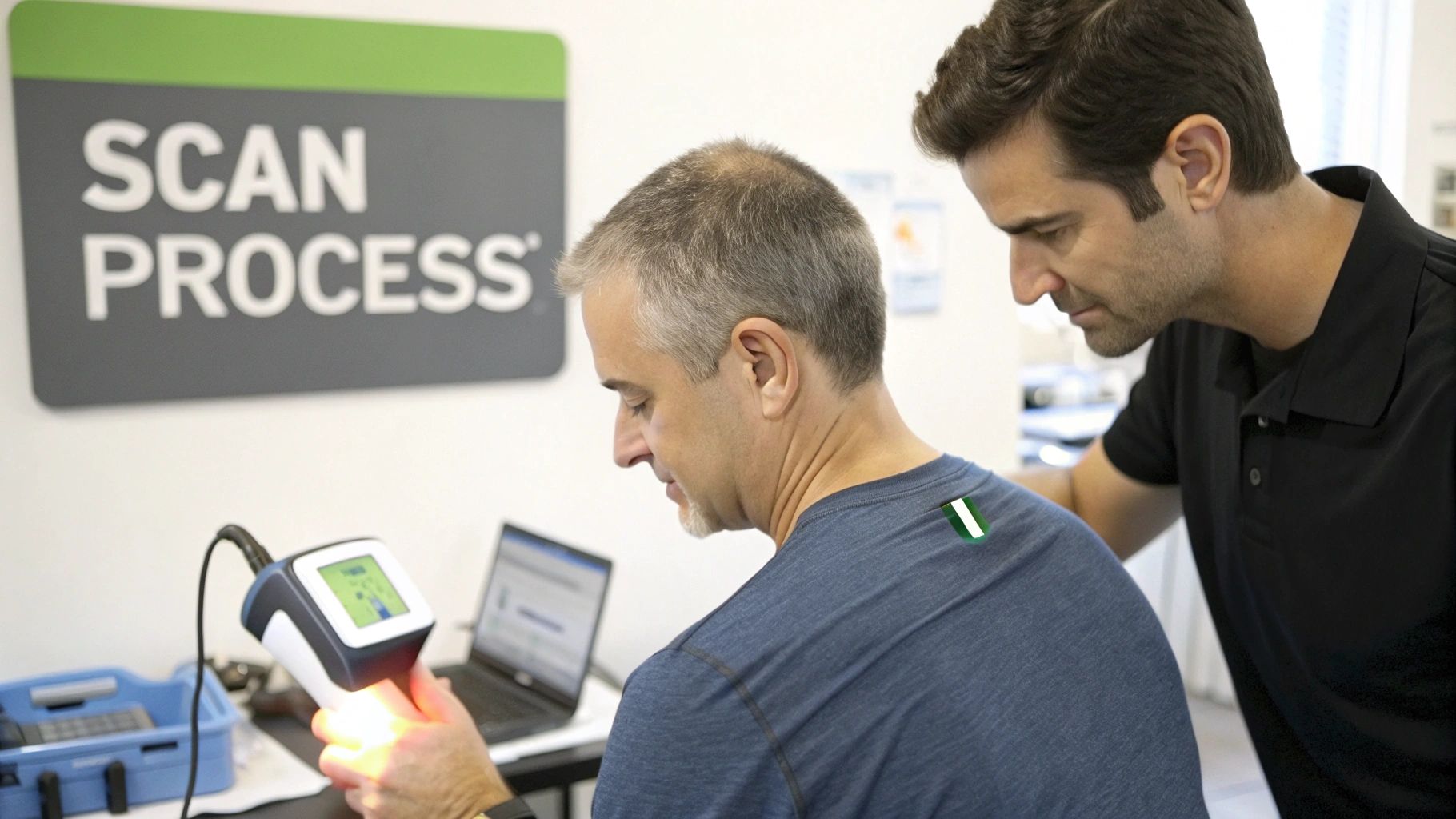
Think of these scans as different chapters in your body's unique story. Each one reveals a vital piece of the puzzle, giving us a comprehensive understanding of your well-being.
Surface Electromyography (sEMG) Reading Muscle Energy
The first part of the story comes from Surface Electromyography, or sEMG. Think of it like an EKG for your heart, but this technology is specifically designed for the muscles that support your spine. The scan's job is to measure exactly how much electrical energy those muscles are putting out.
A small, handheld device is gently moved along your back, reading the tiny electrical currents your muscles produce. This reveals patterns of tension, weakness, or even complete exhaustion. When you're sitting still, healthy muscles should be calm and balanced.
But if the scan lights up with bright, active colors? That’s a clear sign your muscles are overworked, burning way too much energy just to hold you upright. It points directly to underlying stress on your nervous system that’s forcing your muscles into a constant state of defense.
Thermal Scanning Detecting Hidden Inflammation
Next up, we use Thermal Scanning to uncover another layer of your health story. This tool works like a high-tech infrared camera, precisely measuring tiny temperature differences all along your spine.
So, why does temperature matter so much? Your autonomic nervous system—the part that controls organ function, blood flow, and more—also regulates the temperature of your skin. If nerves are irritated or compressed, that process gets disrupted, creating distinct temperature imbalances from one side to the other.
A thermal scan pinpoints "hot spots" where inflammation may be present or areas where nerve function is compromised. These patterns provide critical clues, guiding your chiropractor to the exact location of nerve interference.
This part of the scan is incredibly sensitive, picking up on subtle changes that would otherwise go completely unnoticed. It helps us see what we can’t feel.
Heart Rate Variability (HRV) Assessing Your Stress Resilience
The final chapter is told through Heart Rate Variability (HRV), which gives us a powerful glimpse into your body's overall resilience and ability to adapt. What’s interesting is that HRV doesn't measure your heart rate itself; it measures the tiny, millisecond variations in time between each heartbeat.
A healthy, adaptable nervous system actually produces a high degree of variability. This means your body can easily and efficiently shift between "fight-or-flight" stress mode and "rest-and-digest" healing mode.
- High HRV: Suggests your body is resilient, recovers well from stress, and is generally in a good state of health.
- Low HRV: Indicates your system is stuck in a state of chronic stress, struggling to adapt and recover effectively.
This scan provides objective data on how much "gas" you really have left in your tank. It shows us if your body is in a state of active healing or just barely getting by. By understanding your HRV, we can see how well your nervous system is functioning as a whole. For a deeper dive, you can explore our guide on the connection between functional neurology and chiropractic care.
Together, these three scans give us a detailed, multi-layered blueprint of your nervous system, allowing for precise and truly effective care.
The Real Benefits of Getting a Nerve Scan
Understanding the technology behind a chiropractic nerve scan is one thing, but seeing how it directly impacts your health journey is where its true value shines. It elevates your care from a general approach to a highly specific, data-driven strategy.
The biggest benefit? It turns subjective feelings—like pain or fatigue—into objective, visual evidence. For many people, this is the very first time they can actually see the underlying stress their body has been dealing with for years.

Imagine struggling with unexplained symptoms for months, only to have a nerve scan pinpoint the exact source of nerve interference. This kind of precision allows for incredibly targeted adjustments, making sure your chiropractor is addressing the root cause right from the start. Instead of a one-size-fits-all plan, your care is built around your nervous system's unique needs.
This level of personalization is a major reason why the chiropractic industry is seeing so much growth. Advanced tools like nerve scans give us clear data, which leads to better treatment outcomes and builds patient trust. With the U.S. chiropractic market projected to hit nearly $28.7 billion by 2030, it’s obvious that people are looking for care that delivers measurable results.
A Story of Discovery
Think about a young boy who struggled with focus in school and was constantly restless at home. His parents felt like they had tried everything. During his first visit, a chiropractic nerve scan revealed significant stress patterns in his upper neck—a critical area for regulating attention and calmness.
The colorful charts made the invisible visible for his parents. For the first time, they could see the neurological reason behind his challenges. With a care plan tailored specifically to these findings, the boy began to show noticeable improvements in his ability to self-regulate and focus. His story is a perfect example of how a nerve scan can unlock the path to wellness.
A nerve scan doesn't just show us where a problem is; it shows us your potential for healing. It gives us a clear roadmap to help your body function at its absolute best.
Tracking Your Progress Visibly
Another powerful benefit is the ability to track your healing journey with real, measurable data. Follow-up scans provide concrete proof of progress, showing you exactly how your nervous system is adapting and improving over time. This visual feedback is incredibly motivating and reassuring.
Here are the key advantages you can expect:
- Pinpoint Precision: Identifies the exact location and severity of nerve interference.
- Customized Care Plans: Your adjustments and care schedule are based entirely on your unique scan results.
- Objective Progress Tracking: You get to see tangible changes in your nervous system function over time.
- Enhanced Understanding: Gain a much deeper insight into your own body and how it handles stress.
Ultimately, a chiropractic nerve scan empowers you with knowledge. It helps you understand the "why" behind your symptoms and gives you confidence in your care plan. Understanding how your body is wired is a core part of our approach to nervous system regulation.
Is a Chiropractic Nerve Scan Right for You?
So, how do you know if a chiropractic nerve scan is the missing piece of your health puzzle? While it's true that many people find their way to us after an injury or while grappling with chronic pain, its real power is much broader than that. You don't have to be in pain to see the benefits—it's an incredible tool for anyone who wants to be proactive about their wellness.
The scan is especially insightful for people who are dealing with those persistent health challenges that just don’t seem to have a clear cause. Think about things like chronic headaches, that nagging sciatica that won’t quit, or a deep fatigue that lingers no matter how much you rest. A nerve scan can provide objective, concrete answers. It helps us move past just chasing symptoms to actually uncover the underlying neurological stress patterns that are likely driving the condition.
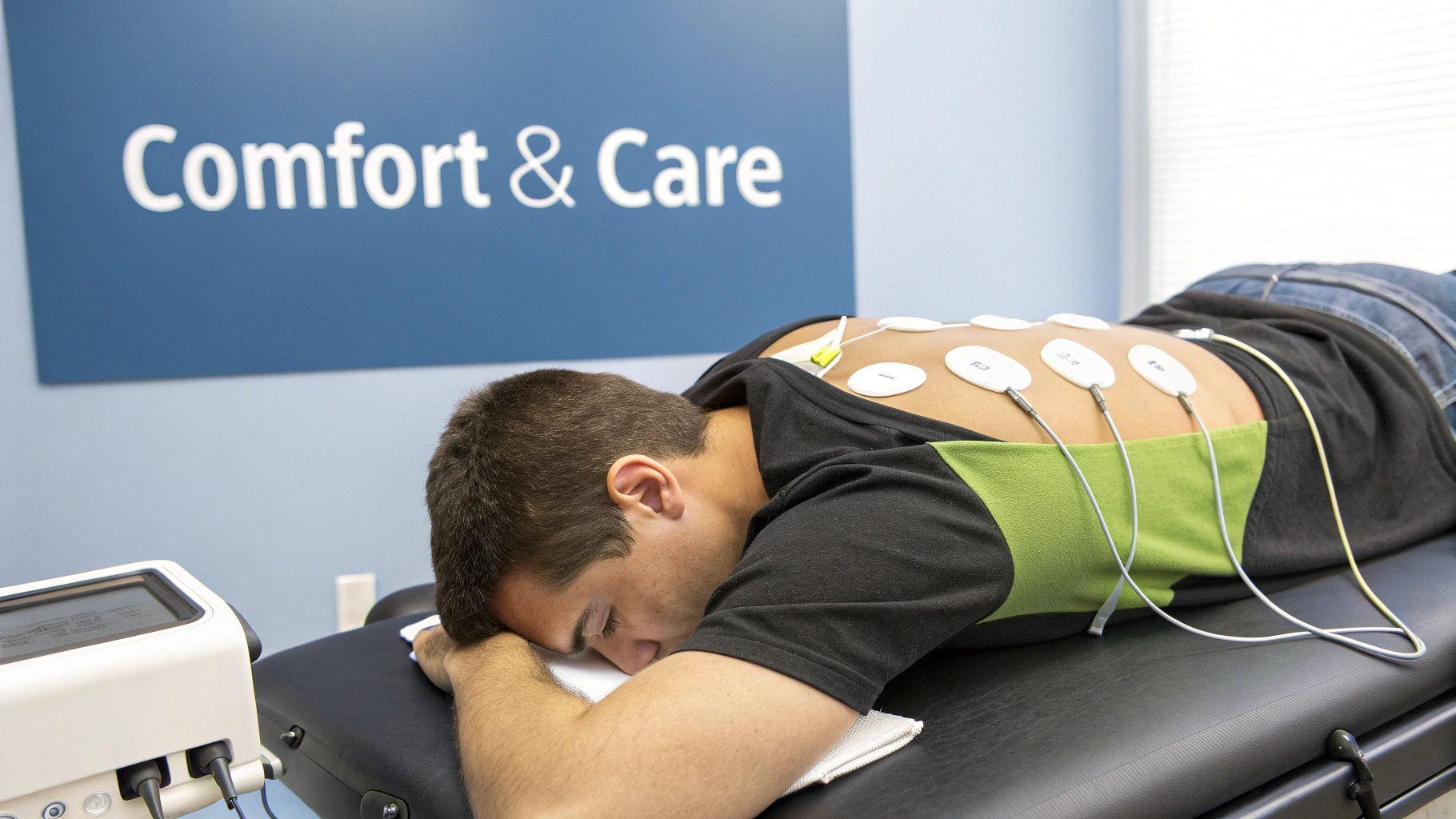
This technology is also a complete game-changer for certain groups of people who can see immense benefits from truly understanding how their nervous system is functioning.
Who Benefits Most from a Nerve Scan?
See if any of these situations sound familiar:
- Individuals with Chronic Pain or Discomfort: If you're suffering from conditions like back pain, constant neck tension, or radiating pain, a scan can pinpoint the exact nerve interference causing the problem. This is particularly helpful for things like pinched nerves, which can be tricky to diagnose without seeing the neurological impact. You can learn more about how chiropractic addresses these issues in our guide on neuropathy symptoms and treatment.
- Athletes and Active Individuals: For anyone looking to fine-tune their physical performance and recover faster, a nerve scan offers a detailed map of muscle balance and nervous system efficiency. It helps us spot hidden weaknesses or imbalances that could easily lead to an injury down the road.
- Parents with Concerns About Their Child’s Development: Because the nerve scan is so gentle and non-invasive, it's perfect for kids. It can give parents valuable insights if they're concerned about developmental milestones, focus, sensory processing, or sleep challenges by revealing hidden neurological stress.
- Anyone with Unexplained Health Issues: Things like digestive problems, persistent fatigue, and brain fog can often be traced back to a dysregulated nervous system. A scan helps us connect the dots between your symptoms and your body’s internal communication network.
A chiropractic nerve scan gives us a baseline understanding of your body’s resilience. It’s like getting a snapshot of your current health and a roadmap for building a stronger, more adaptable nervous system for the future.
The wide appeal of this precise, non-invasive tool helps explain why it's becoming so popular. While back pain accounts for about 44% of chiropractic visits, advanced scans are a key reason why over 35 million Americans now choose chiropractic care each year for a whole host of health goals. Ultimately, a nerve scan is for anyone who wants to stop guessing about their health and start knowing.
What to Expect During Your Nerve Scan Appointment
It’s completely normal to feel a bit curious or even a little nervous before any new kind of health appointment. We get it. That’s why we want to walk you through exactly what your chiropractic nerve scan will look like, step-by-step, so you can feel totally comfortable and confident from the moment you walk in.
The entire process is designed to be gentle, quick, and honestly, pretty fascinating.
Right off the bat, you can relax. The scan is completely painless and non-invasive. There are no needles, no shocks, and absolutely nothing that will make you uncomfortable. We also use technology that is 100% radiation-free, which means it’s perfectly safe for everyone—including pregnant moms, babies, and kids.
The Scanning Process Explained
The actual scan goes by faster than you’d think, usually taking only 15 to 20 minutes from start to finish. Our practitioner will use a few small, handheld scanners that kind of look like a TV remote. They’ll gently glide these devices right along your spine to collect all the data we need.
You’ll be seated comfortably for most of it. As the practitioner moves the sensors along your neck and back, we'll perform three key measurements:
- Thermal Scan: This sensor reads the temperature along each side of your spine. It feels like someone is just lightly running a finger down your back.
- sEMG Scan: This one measures the amount of electrical energy held in the muscles that support your spine. You won’t feel a thing as it takes its readings.
- HRV Scan: For this part, you'll just sit and relax for a few minutes while a small clip on your finger or earlobe measures the patterns in your heart rate. Easy as that.
The whole thing is smooth and straightforward. Your only job is to sit back while the technology creates a detailed map of how your nervous system is functioning.
Reviewing Your Results Together
Now for the best part. As soon as the scan is done, the data is instantly turned into a set of colorful, easy-to-read charts. These visuals make it incredibly simple to see exactly what’s going on inside your nervous system.
Your chiropractor will sit down with you and personally go over every part of your results. We'll explain what the colors and patterns on the charts mean and, most importantly, connect it all back to your specific health concerns and goals.
Think of this as a conversation, not a lecture. It’s your chance to see real, objective information about what your body is going through and ask all the questions you have. You’ll leave your appointment with a clear picture of your neurological health and a solid understanding of the "why" behind your symptoms. That clarity is the first, most powerful step on your journey to feeling better.
We Get It, You Have Questions!
Embarking on a new health journey always brings up a few questions, and that's a good thing! We believe that clear, honest answers are the bedrock of trust. When it comes to something as important as a chiropractic nerve scan, you deserve to feel completely in the loop and confident in the process.
Let's dive into some of the most common questions we hear from new patients at our office.
Is a Chiropractic Nerve Scan Safe for Everyone?
Absolutely. This is often the first question on everyone's mind, especially parents and expecting mothers, and we're happy to give a clear answer: the technology we use is 100% non-invasive and completely radiation-free. This isn't like an X-ray or CT scan; it simply reads the subtle signals your body is already sending out.
Because the scan uses passive sensors to measure what's happening with your nerves and muscles, it's perfectly safe for every member of the family, at every stage of life. This includes:
- Pregnant women who want to understand and support their bodies through every change.
- Newborns and infants, especially those who may have experienced stress during birth.
- Toddlers and children who might be dealing with developmental or sensory challenges.
- Seniors and anyone with existing health conditions.
There is zero exposure to any kind of harmful energy. It's truly one of the most gentle diagnostic tools available today.
Does the Process Hurt?
Not one bit. We get this question a lot, and we're always happy to reassure patients that a chiropractic nerve scan is completely painless.
The entire process involves us gently gliding a few small, smooth sensors along the skin of your back and neck. You won't feel any zaps, shocks, or uncomfortable pressure. Most of our patients describe the sensation as a light touch, almost like someone is slowly running their finger down their spine. It’s a comfortable, easy, and even relaxing experience from start to finish.
The whole point of the scan is to listen to your body, not to cause it any stress. It's just a gentle way for us to gather information and get a better picture of your health.
How Often Will I Need a Scan?
This is a great question because it gets right to the heart of how we track your progress. Your very first chiropractic nerve scan is crucial—it sets your baseline. Think of it as the "before" picture, creating the first detailed map of how your nervous system is functioning right now.
That initial map tells us exactly where we need to focus your care. From there, we perform follow-up scans at key milestones in your care plan. These progress scans are incredibly powerful for a few reasons:
- They give us objective, concrete data showing how your nervous system is responding to care.
- They let us—and you—visually see your healing journey unfold, which is hugely motivating!
- They help your chiropractor make precise, informed adjustments to your care plan to keep the momentum going.
Is the Nerve Scan Covered by Insurance?
Navigating insurance can feel like a maze, since every plan and its benefits can be so different. While many insurance companies are starting to recognize the diagnostic value of chiropractic care, coverage for specific tools like nerve scans can still vary.
Some plans might cover a portion of the cost, while others may not include it in their benefits. The surest way to know is to check directly with your insurance provider. Our team at First Steps Chiropractic is also here to help you get clarity. We can run a complimentary benefits check to see exactly what your specific plan covers, so there are never any surprises.
At First Steps Chiropractic, we believe understanding your body is the first step toward genuine wellness. Our advanced nerve scans give you the clarity needed to take control of your health with confidence. Schedule your complimentary consultation today!
